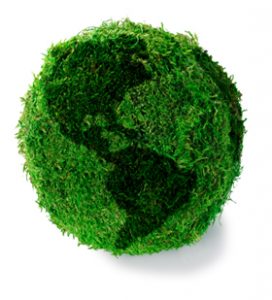5 Organic Lawn Care FAQs and Answers

Each year, 67 million pounds of synthetic pesticides are used on lawns in the United States, and we spend more than $5 billion on fertilizers derived from fossil fuel each year. Many Americans have begun looking into organic lawn care solutions.
What is Organic Lawn Care?
Organic lawn care makes use of chemical free and natural fertilizers and weedkillers. The goal is to keep your lawn healthy without the need for caustic or toxic chemicals. Over time, chemicals can rob the soil of the nutrients grass and other plants need, making it difficult or impossible to nurture a healthy lawn. In addition, some organic lawn care products provide peace of mind if you’re concerned about pets or children interacting with the grass.
How to Fertilize Your Lawn Organically
An organic fertilizing staple is feather meal. Feather meal is a byproduct of poultry farming. As poultry is being processed and sent to stores for purchase, feathers from the animals are ground to a fine powder. This powder contains a lot of naturally occurring nitrogen – an element that is crucial for plant growth.
Feather meal is considered a “slow release” source of nitrogen, which means that grass can get a long-term, consistent supply, instead of getting inundated all at once.
An alternative solution is corn gluten. Processed corn gluten also contains a high concentration of nitrogen, and is considered a fast release fertilizer.
The differences between fast and slow release fertilizers depend mostly on your irrigation setup or climate.
How to Grow a Green Lawn Organically
As we’ve covered before, how keeping green lawn involves a few different lawn care concepts.
As a good rule of thumb, try to keep these three tips in mind:
- Mow high. The closer you cut your grass, the more likely weeds can choke it out by stealing sunlight.
- Don’t over fertilize. As important as nitrogen is for your grass, it is possible to provide too much and “burn” the lawn. Try to fertilize once per year.
- Keep a close eye on pests, and use chemical free pesticides. Since we’re going organic, chemicals were already out of the question.
How to Make Organic Pesticides for your Lawn
First of all, remember that not all insects in your lawn are bad. Even the most diligent lawn-keepers might not notice pests in action, so you’ll have to be on the lookout for early signs of infestation so you can stop the pests early.
One way to approach pesky insects in your lawn is to suffocate them. Lots of insects use pores on their body surface to breath, making them susceptible to viscous liquids like vegetable oil and dish soap. Creating solutions with water and either vegetable oil or dish soap (or both!) are a chemical free and non-toxic way to control pests on your lawn.
Alternatively, you could repel bugs with strong scents. Common scents insects actively avoid include garlic, chiles, and cedar. You might be able to regularly use these additives to keep the pest population down without worrying about harming pets or children.
As always, the best lawn starts with high quality sod and grass. If you’re tired of your lawn looking brown or aren’t sure how to get a fresh start, contact the Grass Outlet today!





